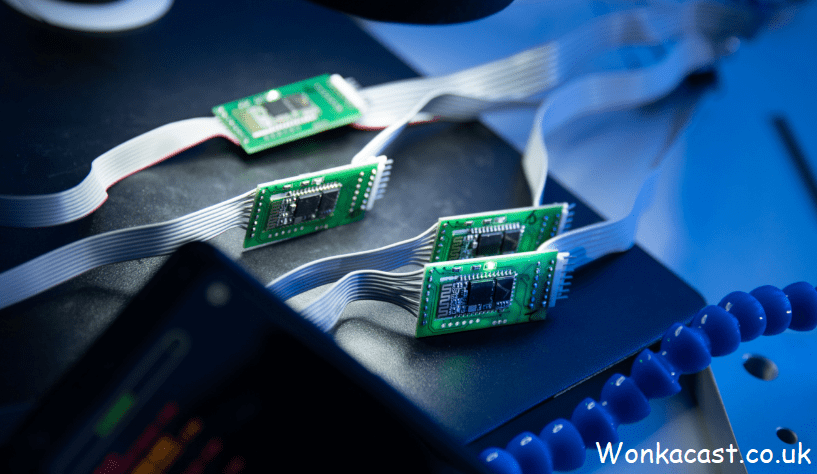Understanding voltage levels is crucial in various fields, from electronics to electrical engineering. This guide aims to clarify what voltage means, how it impacts different devices, and whether 1.369V is considered a lot in practical terms. By the end of this article, you will have a thorough understanding of voltage levels and the specific context around 1.369V.
What is Voltage?
Voltage, often referred to as electrical potential difference, is the force that pushes electric current through a circuit. Measured in volts (V), voltage is essential for powering electronic devices and systems. Without voltage, electric current cannot flow, and devices cannot operate.
In simple terms, you can think of voltage like water pressure in a pipe. The higher the pressure (or voltage), the more water (or current) flows through the pipe (or circuit).
Key Points:
- Voltage (V) is the measure of electric potential difference.
- It determines how much current can flow through a circuit.
- Voltage is fundamental for powering all electronic devices.
How Voltage Works
At the atomic level, voltage is the difference in electric potential energy between two points in a circuit. When a voltage is applied across a conductor, it creates an electric field that causes electrons to move, resulting in an electric current.
The Role of Voltage in Circuits
Voltage plays several crucial roles in electrical circuits:
- Current Flow: Voltage is the driving force that causes current to flow in a circuit. The relationship between voltage, current, and resistance is described by Ohm’s Law, which states that V=I×RV = I \times RV=I×R, where VVV is voltage, III is current, and RRR is resistance.
- Power Delivery: The power consumed by an electrical device is determined by both the voltage and the current. The formula for electrical power is P=V×IP = V \times IP=V×I. Therefore, higher voltage can lead to more power being delivered to a device, provided the current is sufficient.
- Device Operation: Different devices require different voltage levels to operate efficiently. Understanding the required voltage is critical for selecting compatible components in electronic design.
Understanding Voltage Levels
Voltage levels can be classified into different categories based on their application and context. Here are some key voltage categories:
- Low Voltage (LV)
Low voltage is typically defined as voltages below 50V. This category is common in everyday devices such as household appliances, toys, and consumer electronics. Examples include:
- AA Batteries: Provide 1.5V, widely used in portable devices.
- Smartphone Chargers: Typically operate at 5V.
- Medium Voltage (MV)
Medium voltage ranges from 50V to 1000V and is commonly used in industrial settings. It powers machinery and equipment in factories. Examples include:
- Industrial Equipment: Such as conveyor belts and motor drives.
- Substation Equipment: Used to step down high voltage from transmission lines for local distribution.
- High Voltage (HV)
High voltage exceeds 1000V and is used for transmitting electricity over long distances in power lines. Examples include:
- Transmission Lines: Often operate at voltages between 10kV and 765kV, depending on the application.
- Extra High Voltage (EHV)
This category refers to voltages above 100kV, primarily used in transmission systems to minimize energy loss over long distances. Examples include:
- High-Voltage Direct Current (HVDC) Lines: Used for long-distance transmission of electricity with minimal losses.
Contextualizing 1.369V
Now that we understand voltage levels, let’s focus on 1.369V. In the context of electronics, this voltage can be categorized as low voltage. But is 1.369V a lot?
Everyday Comparisons
- Batteries: A standard AA battery provides 1.5V, making 1.369V slightly less.
- USB Power: USB ports typically supply 5V, which is considerably higher than 1.369V.
Technical Context
In specific applications, 1.369V can be significant. For example, in sensitive electronic circuits, even small voltage variations can impact performance. In these scenarios, 1.369V may not seem like much, but it can play a crucial role.
Factors Affecting Voltage Context
When assessing whether 1.369V is considered a lot, consider the following factors:
- Device Type: Different devices have varying voltage requirements. For example, microcontrollers can function well at this voltage, while larger appliances may require much higher voltages.
- Circuit Design: In a well-designed circuit, 1.369V may be an optimal operating voltage for specific components, making it suitable for that application.
- Energy Efficiency: Many modern electronics are designed to operate efficiently at lower voltages. In this context, 1.369V could be seen as advantageous, promoting energy conservation.
Applications of 1.369V in Devices
Microcontrollers:
Many microcontrollers operate at low voltage levels, typically between 1.2V to 5V. Therefore, 1.369V is perfectly within the operating range for many microcontrollers. For example:
- Arduino Boards: Many Arduino boards, such as the Arduino Pro Mini, can operate at voltages as low as 1.8V, making them compatible with 1.369V.
- Raspberry Pi GPIO Pins: The GPIO pins on Raspberry Pi devices operate at 3.3V, and while 1.369V is lower, it still can be used in specific sensor applications.
Sensors:
Various sensors utilize low voltage for operation. For instance, temperature sensors and light sensors often function well within the 1V to 5V range. Examples include:
- LM35 Temperature Sensor: This temperature sensor operates in the range of 0 to 5V, making 1.369V a valid operating condition.
- Photoresistors: Commonly used in light-sensing applications, they can operate effectively at low voltages.
Battery-Powered Devices:
Many portable devices rely on battery technology that allows for low voltage operation. In this context, 1.369V can be considered normal and functional. Examples include:
- Wearable Devices: Smartwatches and fitness trackers often use batteries that operate at low voltages.
- Wireless Sensors: Devices used in Internet of Things (IoT) applications may operate at voltages around 1.369V to conserve energy.
Low-Power Circuits:
Low-power circuits, such as those in IoT devices, can efficiently run on 1.369V, providing an excellent balance between performance and power consumption. Examples include:
- Low-Power Wi-Fi Modules: Some Wi-Fi modules, like the ESP8266, can operate at voltages as low as 3.3V, and while not ideal for 1.369V, it highlights the trend of low voltage consumption.
- Energy Harvesting Devices: Devices that collect energy from the environment may operate at very low voltages, where 1.369V is entirely adequate.
Summary
1.369V is commonly encountered in many electronic devices, particularly those designed for low power consumption. Thus, it is not just a random figure; it has practical implications.
Comparing Voltage Levels
To better understand whether 1.369V is a lot, it is beneficial to compare it with various voltage levels commonly used in different applications:
1.369V vs. Other Voltage Levels
- 0.5V: Low enough to be negligible in many applications but can power specific low-energy devices, such as some RFID tags.
- 1.5V: Standard for AA batteries, making 1.369V relatively lower but still usable in many circuits.
- 3.3V: Common in many digital circuits, particularly for processors, showing that 1.369V is on the lower side.
- 5V: Standard for USB-powered devices, making 1.369V considerably lower than typical USB output.
- 12V: Commonly used in automotive applications, making 1.369V significantly less than what is typically needed.
Practical Implications of Voltage Comparison
When comparing voltage levels, it’s crucial to consider the implications for device performance and compatibility. Lower voltages can lead to:
- Reduced Power Consumption: Devices operating at lower voltages tend to consume less power, which is particularly important for battery-operated devices.
- Heat Generation: Lower voltage levels can lead to less heat being generated in devices, prolonging their lifespan and enhancing efficiency.
- Circuit Complexity: Designing circuits for lower voltages can sometimes require more complex solutions, such as voltage regulators, to ensure stability and reliability.
The Importance of Voltage in Electronics
Voltage in Circuit Design
Voltage is a fundamental aspect of circuit design. Engineers and designers must carefully consider the voltage requirements of each component to ensure that a circuit operates correctly and efficiently. Here are some key aspects of how voltage influences circuit design:
- Component Selection: When designing a circuit, engineers must select components that can operate within the required voltage range. For instance, capacitors, resistors, and integrated circuits (ICs) have specific voltage ratings, and exceeding these can lead to failure.
- Power Supply Requirements: The voltage level determines the type of power supply required for a circuit. For example, circuits that require 5V typically use a USB power supply, while those needing higher voltages, like 12V or 24V, may require dedicated power adapters or transformers.
- Voltage Regulation: Many circuits require stable voltage levels to operate correctly. Voltage regulators are used to maintain a consistent output voltage despite variations in input voltage or load current. For circuits operating around 1.369V, low-dropout (LDO) regulators might be utilized to ensure stability.
- Safety Considerations: Voltage plays a critical role in the safety of electronic devices. Understanding voltage limits helps prevent overvoltage conditions that can damage components or create hazards. Engineers must also design circuits to handle voltage spikes and surges.
- Signal Integrity: In digital circuits, voltage levels represent binary data (0s and 1s). Maintaining clear voltage levels is essential for signal integrity, which ensures reliable communication between components.
Voltage and Signal Processing
In the context of signal processing, voltage levels directly relate to the quality and accuracy of signals transmitted and received. For example:
- Analog Signals: In analog systems, small changes in voltage can significantly impact the output signal’s quality. A 1.369V signal may represent a specific analog value in a sensor output.
- Digital Signals: In digital circuits, specific voltage thresholds are established to distinguish between high (1) and low (0) states. A voltage level of 1.369V may be interpreted as a logic low, depending on the system’s threshold levels.
- Signal Conditioning: Voltage levels often need conditioning (amplifying or attenuating) to ensure they fall within the required range for processing. This is particularly important in communication systems where voltage levels determine signal quality.
Voltage Measurement Techniques
Measuring voltage accurately is crucial in diagnosing and designing electrical circuits. Various tools and techniques are used to measure voltage levels effectively. Here are some common methods:
1. Multimeter
A multimeter is one of the most common tools for measuring voltage. It can measure AC and DC voltage across a wide range of levels. To measure voltage with a multimeter:
- Select the Voltage Setting: Choose either the AC or DC voltage setting based on the circuit type.
- Connect Probes: Place the red probe on the positive side and the black probe on the ground or negative side of the circuit.
- Read the Display: The multimeter will display the voltage reading.
2. Oscilloscope
An oscilloscope provides a visual representation of voltage signals over time. This is particularly useful for observing changing voltage levels in a circuit. Key steps include:
- Connect Probes: Attach the probes to the points in the circuit where you want to measure voltage.
- Set the Time Base: Adjust the time base to capture the desired frequency of the signal.
- Analyze the Waveform: Observe the waveform on the screen to understand the voltage behavior in real-time.
3. Voltage Data Loggers
For applications where voltage levels change over time, data loggers can record voltage readings continuously. These devices can help analyze trends and anomalies over extended periods. Features include:
- Set Measurement Intervals: Choose how often to record voltage readings.
- Store Data: Data loggers store readings for later analysis.
- Export Data: Many devices allow data to be exported for further analysis in software applications.
4. Specialized Voltage Probes
In high-frequency or high-voltage applications, specialized voltage probes are used to measure voltage without affecting the circuit significantly. These probes are designed to minimize loading effects and ensure accurate readings.
Summary of Measurement Techniques
Accurate voltage measurement is vital for troubleshooting, circuit design, and ensuring devices operate within safe limits. Understanding how to use different measurement tools enhances an engineer’s ability to diagnose issues and develop reliable circuits.
Safety Considerations
Working with electrical circuits always entails certain risks, and understanding voltage levels is crucial for ensuring safety. Here are some essential safety considerations:
1. Understanding Voltage Ratings
Every electrical component has a voltage rating, indicating the maximum voltage it can handle safely. Exceeding this rating can lead to:
- Component Failure: Components may burn out or become damaged, leading to circuit failure.
- Fire Hazards: Excessive voltage can generate heat, posing a fire risk.
- Electrical Shock: Higher voltages pose significant risks of electrical shock, which can be life-threatening.
2. Using Personal Protective Equipment (PPE)
When working with electrical equipment, it’s vital to wear appropriate PPE, including:
- Insulated Gloves: Protect against electrical shock.
- Safety Glasses: Guard against potential debris or sparks.
- Non-Conductive Tools: Use insulated tools to minimize risk during repairs.
3. Working with High Voltage
If working with high-voltage systems, follow specific safety protocols:
- De-energize Circuits: Always ensure circuits are de-energized before working on them.
- Use Barriers: Maintain a safe distance from live components and use barriers to prevent accidental contact.
- Have an Emergency Plan: Know how to respond in case of electrical emergencies.
4. Circuit Protection Devices
Incorporating protective devices such as fuses, circuit breakers, and surge protectors helps safeguard circuits from excessive voltage levels. These devices are designed to interrupt the circuit when voltage levels exceed safe thresholds.
5. Education and Training
Staying informed about electrical safety standards and practices is crucial. Participating in training sessions or workshops can enhance knowledge and skills, reducing the risk of accidents.
Practical Examples of 1.369V Usage
To illustrate the significance of 1.369V in practical applications, let’s explore some real-world scenarios:
1. Battery-Powered Sensors
Many battery-powered sensors are designed to operate efficiently at low voltages. For instance, environmental sensors that monitor temperature and humidity often operate between 1.2V to 3.3V. A voltage of 1.369V may be the ideal operational voltage for such devices, optimizing battery life while providing accurate readings.
2. Wearable Technology
Wearable technology, such as fitness trackers and smartwatches, frequently employs low voltage. Devices designed to operate around 1.369V can effectively monitor various health metrics while minimizing power consumption, leading to extended battery life.
3. Low-Power Microcontrollers
Microcontrollers are fundamental components in many electronics, and many are designed to work at low voltage levels. Using 1.369V can help extend battery life in applications such as:
- Robotics: Small robots can run on lower voltages, allowing for lighter designs and improved battery efficiency.
- IoT Devices: Many Internet of Things devices, such as smart home sensors, are designed to operate efficiently at low voltage levels.
4. Audio Equipment
In audio devices, low-voltage applications are common. For instance, some audio amplifiers operate effectively at 1.369V, allowing for high-quality sound output while minimizing power consumption.
5. Low-Power Communication Devices
Low-power wireless communication devices, such as Bluetooth transmitters and receivers, may operate at voltages around 1.369V. This level of voltage allows for efficient communication while reducing energy consumption.
Conclusion
Understanding voltage levels is vital in electronics, and 1.369V is an example of a low voltage that plays a significant role in various applications. This guide has covered the following points:
- Definition of Voltage: Understanding what voltage is and its role in electric circuits.
- Voltage Levels: The classification of voltage levels and the significance of low, medium, and high voltage.
- Contextualizing 1.369V: Assessing whether 1.369V is a lot by comparing it to other voltage levels.
- Applications: Exploring how 1.369V is utilized in different devices, especially in low-power electronics.
- Measurement Techniques: Discussing tools and methods for measuring voltage accurately.
- Safety Considerations: Highlighting the importance of understanding voltage for safe electrical work.
- Practical Examples: Providing real-world applications of 1.369V in various electronic devices.
In conclusion, while 1.369V might not seem significant when compared to higher voltages, it is a crucial voltage in many low-power applications. As technology continues to advance, operating at lower voltages becomes increasingly important for energy efficiency and device performance. Understanding these concepts not only enhances your knowledge of electronics but also ensures safety and reliability in your projects.
FAQs
What does it mean if a device operates at 1.369V?
It indicates that the device is designed to function efficiently at a low voltage, which can lead to reduced power consumption and prolonged battery life.
Is 1.369V safe to touch?
Generally, voltages below 50V are considered low voltage and are typically safe to touch, but caution should always be exercised when working with electrical devices.
What types of devices commonly use 1.369V?
Many battery-powered devices, such as sensors, wearable technology, and low-power microcontrollers, often use 1.369V for their operation.
How can I measure 1.369V in a circuit?
You can measure 1.369V using a multimeter set to the appropriate voltage range (DC or AC), or by using an oscilloscope to visualize the voltage over time.
What happens if a component receives more than 1.369V?
If a component designed for 1.369V receives a higher voltage, it may overheat, become damaged, or fail altogether, potentially causing a short circuit or fire.
What precautions should I take when working with low voltages?
Even at low voltages, it’s essential to use insulated tools, wear protective equipment, and ensure the circuit is powered off before making modifications or measurements.
Can I use regular batteries to supply 1.369V devices?
Yes, you can use standard batteries (like lithium-ion or nickel-metal hydride) that provide nominal voltages within the range needed for devices operating at 1.369V.
Are there any specific voltage regulators for 1.369V applications?
Yes, low-dropout (LDO) voltage regulators can be used to maintain a stable 1.369V output, ensuring the device operates within its required voltage range.
What is the significance of low voltage in IoT devices?
Low voltage allows IoT devices to operate efficiently, extending battery life and enabling smaller designs, which are crucial for the proliferation of these technologies in smart environments.
What trends are emerging in low-voltage electronics?
Trends include increased miniaturization of components, enhanced energy efficiency, and the development of new materials and technologies that enable devices to operate effectively at lower voltages.







